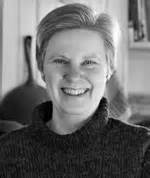 Mary Swander is Iowa’s poet laureate, a distinguished professor at Iowa State University, and the recipient of numerous awards, including grants from the National Endowment for the Arts. She is the author of the memoirs The Desert Pilgrim and Out of This World, the plays Maps of my Kingdom and Vang, stories and articles, and several books of poetry. Below, she talks with Lauren K. Alleyne about the essential ingredients of the writing life: rootedness, seeds, following your passions, engaging many voices, and getting your butt in the chair—with or without a banjo.
Mary Swander is Iowa’s poet laureate, a distinguished professor at Iowa State University, and the recipient of numerous awards, including grants from the National Endowment for the Arts. She is the author of the memoirs The Desert Pilgrim and Out of This World, the plays Maps of my Kingdom and Vang, stories and articles, and several books of poetry. Below, she talks with Lauren K. Alleyne about the essential ingredients of the writing life: rootedness, seeds, following your passions, engaging many voices, and getting your butt in the chair—with or without a banjo.
LKA: Since 2009, you’ve held the office of Poet Laureate of Iowa. What’s that experience been like?
MS: It’s been incredible. I have gone into grade schools, junior high, high schools; I’ve gone to almost all the colleges and universities across the state; I’ve gone to prisons and into assisted living centers. I’ve given readings, performances, classes and workshops with people of all ages, and one of the things I’m excited about is that there are so many groups of people in the state that are interested in poetry and literary arts that you would not typically expect.
Last week, for example, I gave the welcoming invocation to the Motor Vehicle Administrator’s International Conference. I didn’t know what the heck I was going to, and it turned out to be 3000 people who gathered in Des Moines from Canada, the US, and Mexico who were all the police arm having to do with motor vehicles: the DOT, the state troopers, police officers, light rail workers. Of course my first thought was that they’re not going to respond to poetry, but they did. It was overwhelming. They loved it. I only read the one poem, but they loved it, and they all wanted copies of it.
You know, as a poet, you kind of get into a little hole, thinking only other poets like poetry, and this experience widened my sights quite a bit because there are people from all walks of life, all age groups, all interests who do relate to poetry and who appreciate it.
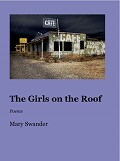
LKA: In addition to being a writer, you’re also a gardener, a teacher, and a musician. How do these different facets of your identity play together, and how do they influence your writing?
MS: I’ve always had these passions, and to be clear, they’re more than hobbies—people say I have so many hobbies, but I think of them as passions. I grow almost all my own food, and I was at that a long time before I realized that it could be part of my writing material. Basically it took me so long to realize because I went the traditional route; I went to the Iowa Writers Workshop for my MFA. And it’s all very exciting when you’re there because you’re with a lot of other talented people, but on the other hand, it’s a microcosm. You don’t really have a life. You’re just in school, and so you’re not writing about a wide range of topics.
But I let my passion for growing things into my life, and now I have a whole body of work about horticulture and agriculture. In terms of teaching, I was at Iowa State, so that was a good fit because Iowa State is a land-grant university and has a sustainable agriculture program. Then everything started to cohere. And I think that’s what a good writing life should do—one thing seeds another.
And then another one of my passions is playing the banjo, so now I just perform with the banjo— what the heck, I let it into my writing life, too! And you know, things became a lot more fun. I think the more we get away from the standard boring model of stand up and mumble through 10-12 poems as fast as you can and sit down, and call that an entertaining reading, the better off we’ll be. I’ve worked all my life to try to create readings that are much more interesting than what I’ve seen traditionally. I want to be more engaging and surprising, and fun for people to attend.

LKA: You talked about letting things into the poetry and into the writing life, and I feel like the Amish, for example, have made their way into lots of your writing, most recently the Three Stories, that beautiful chapbook. Tell me a little about your relationship to place.
MS: When I was in my twenties, I saw all the writers—or a whole lot of the writers that I knew and loved—love—live the gypsy life. They moved from one place to another to another to another, then they wouldn’t know where they were; they didn’t appreciate where they were; they didn’t appreciate the culture there, the language, whatever, and then they’d wind up making fun of the place where they were. And I thought, I don’t want to live that life! And so my philosophy was to be more rooted than that. If you constantly move around your whole life, you’re never going to understand a place in terms of its deeper ecology— its environmental issues or social justice issues or the conflicts among its people or the richness and texture that it has to offer.
So I always try to explore place. I really think every place has so much to offer in really different ways. It could be geography, geology, botany, or culture. There’s so much to experience. I just can’t imagine being in a place and just curling up and closing the door. Which is what a lot of writers do! It’s very weird to me.
I think you have to have some roots to plumb the depths of a sense of place in order to have more substance to your writing. Or you just wind up skimming along the surface, or you wind up completely cerebral. I think that’s where poetry has ended up in the last couple decades. You know, poets are running around living the gypsy life, and there’s no connection to the place they’re living, so all their material is cerebral. And there’s nothing wrong with cerebral poetry, but it excludes certain audiences.

LKA: You literally invite the community into your work. How did you hit on that as a method, and how does it work creatively?
MS: That’s been great! I got going on that on a play called Farmscape. I wrote that in a class with my students. Each student in the class took on a different character who represented a different issue in the changing agricultural landscape. The students interviewed the character and shaped the material into a dramatic monologue, then we wound the monologues together into a script. When it was time to perform the play, I’d go into a town or school and people from the community would step forward to be the actors.
And they weren’t necessarily trained actors, so, of course, there were rough edges to it, but that was just a part of it. The most amazing thing was going into a town with 900 people, and there’d be 10 actors from this town of 900—not 9000—and there’d be someone who’d say, “I never knew any of these people, this is great!” And so in this way the play was creating community on three levels—community in the classroom, the community with the town in performance, and then within the town itself. And then those actors would bring their family and friends, and there’d be a band; most times, the band would make up music for the show, and so it really became an event.
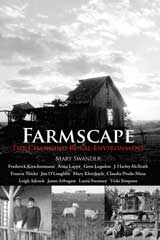
Last night I was in a hunting lodge near Decorah, Iowa—a hunting lodge with deer heads and antlers all over the walls—and we were doing a performance of Map of My Kingdom. Map of My Kingdom is my latest play commissioned by Practical Farmers of Iowa about farmland transitions—who’s going to inherit the farm when you croak. Anyway, we’re performing in this lodge for around 40 farmers in the room and tears were streaming down their faces; it was the most amazing thing! Most of the time we do that show for groups of farmers who’ve never been to live theatre before, so the performance is doing things on lots of levels there, too; the performance is educating them on theatre, the issues, and it’s getting them to come out and start a conversation.
My sense of the world is there are lots of good people out there in screwed up systems. We have systems in the United States and in the world that are oppressive, and create everything from poverty to disabilities to mental damage. We just have a lot of bad systems. And I look at people who have beliefs completely opposite to mine, and I see them respond to something like the strands of a play. And the art becomes a way to make a bridge with people, to have them open up to you and you open up to them.
Most of us run around in these bad systems pointing fingers at people and closing doors, so through my writing I try to open doors. I love difference. I love anything that’s not the typical American suburb. So I wind up with the Amish, and I write about Hispanic mystic healers, I teach on a Native American Reservation, and gosh, I have had some pretty extraordinary experiences.
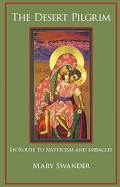
LKA: You’ve been teaching for over 30 years. What are some of the things you try to give to your students, and what have you learned from your students?
MS: I always think of it as two-pronged. On the one hand, my students need style and structure; they really need technique. Most of them come in with having some creative writing, but it was always the fun model—let’s get you going—so it’s fairly freeform. They can write well, most of them, but the writing needs to be shaped: they need to learn how to self-edit; they need to learn how to create structure; they need a lot more facility with technique of all sorts. So there’s that level, and that’s something I think is important.
On a higher level, they need to be able to conceptualize, and think through what they’re trying to write in terms of what it’s really about. I give the students an assignment in my non-fiction class, and it’s that they have to think of a book they want to write, and that they want to pitch to an agent, and they need to describe in one sentence what it’s about. It’s really tough, but my agent used to give me that assignment, and it really makes you focus and ask, What the heck am I doing? What am I trying to achieve? That’s what I try to do for my students.
They’ve given me more than I’ll ever been able to give them in return. I’ve really enjoyed my students. I’ve gone home with them for Christmas! Had my aura cleansed in the Caribbean Sea! Sometimes I fall out of touch and then maybe ten years later, a student pops up again and it’s always so interesting to hear what they’re up to. I love that. I love keeping in touch with former students and just trying to figure out what their perspectives are, what their points of view are, how they’re evolving.
There are a lot of teachers who superimpose their points of view on their students, and ultimately that doesn’t work; it stifles the student. You don’t want everybody writing like you, and you don’t want everybody thinking like you, for sure. And so to me, critical thinking is about developing students’ own thought processes. You want them all to be writing in their own voices, and not like each other, not like the teacher. It gets scary to me when I see teachers who are great writers, who surround themselves with students who write just like them, and it’s like (scream!) Please, do not do that! And you know it’s probably subconscious. We like people who are like us.
I studied with Marvin Bell for a couple semesters when I was at the workshop and he just insisted on that variety. He’d come in and say look at this worksheet: there are poems in every kind of style and every kind of stance, and that is great. Nobody is writing like anybody else in here. I’ve always appreciated that!
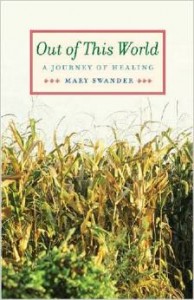
LKA: You mentioned your agent, and I remember learning the term “po-biz” in your class. What non-writing lessons have you learned in your career that you consider to be important?
MS: That is something that is not discussed much in traditional workshops. We pretty much concentrate on the writing, but I try to give my students something more about the business of writing. Iowa State has these mini grants, and I saw one once about entrepreneurship; they were giving grants for entrepreneurship integrated into the classroom. So I wrote up a little manual for how you go about getting published, because that’s an entrepreneurial thing—it’s a job. It’s something you have to work at, and there’s a business to it. I’ve attached that to every syllabus that I’ve had there for the last five or six years!
I know a lot of talented writers who couldn’t handle the business part of writing and they never ended up publishing anything. It’s not always the most talented writers that end up successful, either; you need to be a talented writer, but you also need to get through the business part. You need to harden yourself to rejection. You have to know how to revise. You have to know how to send things out appropriately, and how to read and suss out markets.
And then you need to know how to market. These days, especially, 50% of it is knowing how to sell the work. It’s a totally different ballgame than even, say, 10 years ago. Now you self-publish, self-promote, self everything, and there’s good and bad to that.
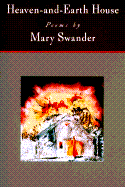
LKA: Who are some contemporary writers you find inspiring?
MS: There are so many! I studied with Stanley Plumly and I’ve always loved his work. And writers like Charles Wright, Claudia Rankine, Anthony Doerr, Toni Morrison, Jane Smiley, Rudolfo Anaya, Howard Norman, Barbara Ehrenreich, Caryl Churchill, Sarah Ruhl, Linda Hasselstrom, Kathleen Dean Moore.
I read widely across genres. Poets tend to read poetry, fiction, non-fiction. I’ve added drama to the list. For some reason, for the most part, fiction writers tend to read fiction. I’m always looking for writers who capture the cracks of a culture, who penetrate those bad systems we’re living in and give one hope that there might be a different way of doing things.
There are so many voices of difference now, which is fabulous, just fabulous; the world of poetry was so narrow before. Actually, I just moved and had to go through all my belongings—basically my whole life—and out fell these various letters that I kept from writers over the years. One of them was from Nikki Giovanni! And I thought, Oh my God! I think back to when I was in high school or college, when she broke onto the scene and it was revolutionary to see a woman of color who had real guts and would address issues of race and oppression and wasn’t afraid to just get up there and go and run with her poetry, and you know, people like her opened the door for lots of others.
And I read varied voices. There’s just a wealth of things I’ve got on the shelf . . . when I was moving I took three car loads of used books to the Planned Parenthood book sale. And I thought, when did I get all these books?
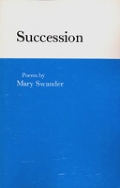
LKA: You’re also a writer in multiple genres—fiction, non-fiction, poetry, drama. Talk to me about what it’s like to operate in these multiple modes of writing.
MS: I think of myself as a person of letters rather than a poet or a fiction writer. And all those genre things are there anyway, because it’s easier to teach. Things used to be much more fluid. First of all we didn’t have writers in the academy until really the 1970s, and before that writers supported themselves by journalism. Then you would write your creative writing when you could. Writers were always shifting around genres like that. And, you know, Wallace Stevens was an insurance agent, William Carlos Williams was a doctor—people had real life jobs, and did different kinds of writing.
And then all of a sudden, writers got put into academe and we had to teach courses, and then it was easier to say this was a poetry workshop, this is a fiction workshop, instead of having ten different people doing ten different things in a class. Of course, we created the problem that then people didn’t think they would write in any other genre. It’s just silly.
One of the things I like about our program at Iowa State is that we don’t have those boundaries; you could be a poet and take a fiction workshop or non-fiction or whatever it might be, just to try your hand at it. But some programs are designed so that if you’re admitted in one genre, you can’t take a class in another one. And my idea is that one feeds another and they are certain things that one genre can do better than another, and so I usually have the idea first and then I think oh, what genre should I present that in? Most writers, of course, are ultimately more talented in one genre than another, but young writers should be informed about the whole spectrum of literature.
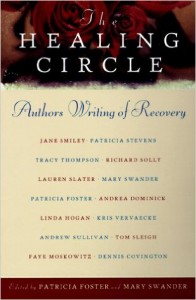
LKA: In another interview you once said, “One of the best things we can do with our lives is writing.” Why is that? What do you think is the role of the writer?
MS: I think our job description is to reflect upon the world. And that could be in any avenue that appeals—it could be reflecting on nature, or reflecting on politics, or reflecting on culture. I think writers make people really uncomfortable, and I have had other people ask me this too, you know, they ask what is it with these writers they have so many. . . quirks. And I say you can’t really be a good writer if you’re in the mainstream, because you need to be constantly looking at the norms, and evaluating those norms, and challenging them. You need to bring up the issues to people, and even if you’re not a conflict-based writer, you bring your idea of beauty. And I really think that makes people uncomfortable, but I think that’s our job—to make people uncomfortable. So there!
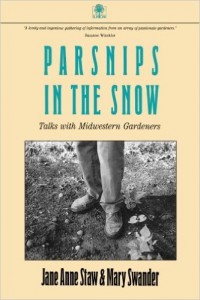
LKA: What’s the challenge of being a female writer, and have those challenges shifted?
MS: That’s what I was taking about earlier with Nikki Giovanni. She was one of those breakout people, and people either loved her or hated her, and if they hated her they made fun of her in the old days. But even when I was in graduate school there were just a handful of women; almost all of the writers were men, most of the faculty were men. They’d make a big effort to try to find a woman a year. It was tough.
Now, we have a hard time finding male students. In my experience, the men are definitely the minority now. It’s amazing. Last year [at ISU] we admitted nine females and one male to the program. It’s a sizeable shift, and that’s happened in other career fields, too. There was a time in my life when I was younger and I wanted to be a vet. This was in the late sixties; basically, it was women need not apply. They admitted no women to the vet school. And now, women are 60% or so of the students in vet school, and it’s the same in medical school. Women physicians were really rare until probably the 1990s and now, they’re far and away more common. That’s been very gratifying and interesting to watch.
When I first started publishing and I gave readings, I would be introduced as , “Mary Swander, domestic poet,” and I would be like, what? And that was the cliché for any woman writer—you were automatically domestic. Once I asked what that was about, and my male host said, you don’t write about hunting and fishing! And I thought, oh, is that the criteria? I knew men who didn’t write about hunting and fishing, were they domestic poets as well? There were so many stereotypes and clichés!
We’ve gotten beyond those clichés a bit, which is great. And women started becoming editors and professors, too. It’s so good to have more female voices, more female writers, more female professors, all of those things; it’s so much more balanced now.
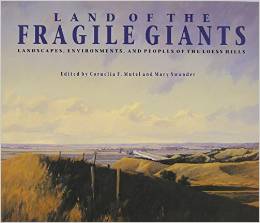
LKA: How do you integrate that shift with, for example, VIDA’s counts that show there are still much fewer women represented in publications, or the stats show that women are less read because men almost exclusively read male writers, and women also read more male writers than female ones?
MS: Oh, we still have a long way to go. Just looking at the political candidates that tromp through Iowa, the women are so often accused of being strident and shrill. And they’re not supposed to talk in soprano voices—the higher their voices the less people like them. The male register is still the norm—it even extends to vocal chords! The literal and symbolic voice! And, of course, women have the same bias too against other women. That digs me, too, really, how stereotypes are so deep in our psyche that we can’t even get out of the ones we’re in!
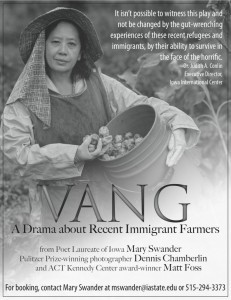
LKA: What advice would you give to our readers—who are women, teachers, MFAs, writers, readers of all stripes?
MS: Number one: make time for yourself and your writing. Do that, or else you’ll be standing there ironing, like in that Tillie Olson essay. I read that long ago and I thought that I had to take that seriously. Women can get so caught up in doing all the work of family and workplace and that they neglect their writing. So you have to arrange time for yourself.
Number two: you have to cut through the self-confidence problem. You wouldn’t believe how many young people say, “Oh, but you have great self confidence. You never have a problem with that!” But I let them know, no, I battle with that every single day. As women we’ve always been told we’re inferior, we’re dumb, we’re stupid, and we internalize all that. I mean, a study just came out about math skills, and it turns out that women are just as good, maybe even better, at math, but math teachers all through school tell young girls that they’re not good at math, and so their confidence fails and they think they’re not good at it. You really have to watch out for that kind of thing; you just have to cut through that crap. Identify it and understand it when it pops up, and then push it aside.
Number three is to get your butt in the chair and just do it! People ask me all the time how I get so much stuff done, and the answer is I sit at my desk and I do it. I write. I give myself assignments and I accomplish them. You can mess around, you can talk about it, or whatever, but if you don’t actually get your butt in the chair . . . the work doesn’t get done!
great interview Lauren and Mary. So good to hear Mary’s voice again. Such fond memories of her as a teacher extraordinaire and companion and guide to the many Iowa cultures. Thank you.
So glad you enjoyed the piece, Joan! Mary has sown many seeds that continue to bear artistic fruit. It’s wonderful to see how many of her students (like Lauren) have gone on to their own successful poetic careers.